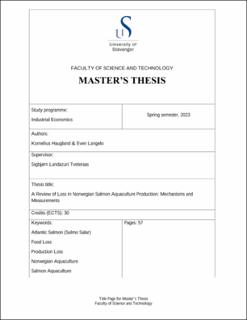| dc.description.abstract | To maintain economic, environmental, and ethically sustainable production in the food industry, minimizing losses is a key objective. This thesis investigates the mechanisms driving losses and how losses are quantified and measured in the Norwegian Atlantic salmon aquaculture industry. The objective is to provide an increased understanding of losses and measurements to aid towards the reduction of food loss (FL). Based on a review of available literature and statistics, it is found that losses in the industry are driven by a complex set of mechanisms. The majority of losses occur due to mortality during production at sea. Salmon delousing treatments are a key contributor to losses and can lead to episodes of high mortality when performed in conjunction with underlying health impairments. The most frequently performed delousing regimens, thermal- and mechanical treatments, are associated with the highest mortality increases.
Norwegian salmon is at risk of contracting to a series of diseases and infections, where the most detrimental are complex gill disease, cardiomyopathy syndrome, and winter ulcers. It is found that each year approximately 16 % of all salmon end up as a loss. On the national level, losses exhibit a decreasing trend. However, the average weight of harvested salmon is decreasing, likely caused in part by high pressure on farmers to keep lice levels low. Losses and mortalities vary significantly depending on year and location, and no county produces a consistent number of harvests per lost individual. Several challenges exist relating to quantity control and loss measurement during production, and current measurement technology is imprecise and can cause negative health effects in fish. Monthly reports of biomass and loss numbers are associated with significant uncertainties. The industry would benefit of precise equipment for stock measurements during production at sea, and increased data generation is necessary to improve the current understanding of factors driving losses and mortalities. | |
